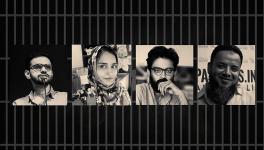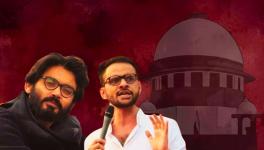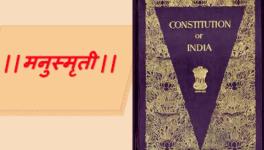Pattern and Design Point to a Plan
Some of my respected friends refuse to admit there is any pattern and discount conspiracies in the “Delhi violence”, as it is referred to in sanitised versions. I fear that they also discount the habitual cunning and deceit with which Fascists work. Remember the notorious Reichstag Fire in which Nazis burned down the entire Parliament House of Weimar period Germany to disrupt official business of the government. They arrested a mentally unstable former Communist party member and cooked up a far-fetched plot by Communists—their mortal enemies—as the alleged culprits. We should not grudge the same degree of guile and enterprise to their Indian avatars.
Chronology is of the essence. Hardly had the embers of Delhi conflagration died than the Home Minister thundered that the CAA was not an instrument to deny citizenship of “our Muslim brothers and sisters”. The BJP also took out a procession in Delhi in support of CAA. The idea seems to be that the Delhi violence has finally clinched this contentious issue!Similarly, the provocations by the saffron spokesmen ahead of the riots surely cast a lurid light on traces that might get lost in newly-discovered evidence of Muslim complicity from the beginning.
I would like to draw attention to one more thing. Ever since CAA had been rushed through both Houses with speed like that of a gale, BJP leaders have been saying two things. First is their repeated assertion that Nehru and other Indian leaders formally opened the doors to ‘refugees from religious persecutions in neighbouring countries’. Actually, as Dinesh Dwivedi has proved so ably in a recent article in The Wire, Nehru and other leaders at that time had in mind two streams of migrants, both coming to India: the Hindus escaping atrocities by crazed votaries of Pakistan as a Muslim state, and the Muslims who had been driven to seek shelter in Pakistan by raging saffron mobs returning to their homes in India following an assurance of security by the Indian government. And this refers to events up to 1955 or thereabout. There was no allusion to religious persecution.
Second is their constant insistence that the ‘unfinished agenda of 1947’ is to be completed today with finality. This sounds rather like the Final Solution of the Nazis. But what do they really mean by it? There had been no such agreed agenda in the period following independence. We formally chalked out a national agenda with the completion and adoption of the Constitution.
Then what do they mean by it? We can form an idea by considering the forming and crystallisation of the saffron mindset. We must firmly grasp the elusive fact that these groups believe in and draw lessons from an altogether different history than what is to be found in accepted academic work and among educated circles. They are convinced the country had been divided on religious-communal lines. The argument among them in 1947 was that since Hindu migrants in their millions had exited or been driven away from Pakistan, all Indian Muslims should likewise be driven away to Pakistan.
They have continued to believe, contrary to ideas we have long held, that the circle is yet to be completed. It remains an article of faith with them that Muslims should be compelled by pressure, including violence, to ‘go back to their natural homeland’. Hindustan is the natural home of Hindus, they insist still, and Pakistan or some other Islamic country is the natural homeland of Muslims that inhabit India. If Muslims want to remain here it will have to be under terms set by ‘Hindus’. One might think it crazy. But it is this crazy logic that has often driven nightmare projects.
The Wheels of Justice
The ‘riots’ in Delhi, a replay of the 1946-7 riots after a gap of more than 70 years, surely cannot be played down as an unfortunate conjuncture of circumstances. The major role in the grim and deadly violence is that of the same forces that had led the mobs then, now led by armed and trained mobs who systematically carried out the massive arson and destruction as well as the slaughter. Most importantly, they were on both occasions driven by the same ideology and organisations. Finishing ‘the unfinished agenda of 1947’ is now the war cry, underlining the continuity.
It is therefore almost a waste of time to analyse the psychopathology of the rioters or speculate on how lack of alertness of government and the mutual recriminations of ‘two hostile groups’ coincided to turn a flicker into a blaze. Politics is of paramount importance here and mere humanitarianism an inadequate, even dangerous, response.
It is in this connection that the judiciary’s part claims our attention. The honourable judges of the Supreme Court have rued, not without reason, that much more has been expected of them than what the scope of judicial intervention would normally allow. First the High Court was attending to it and there has been some action there, ruling out a pre-emptive arrogation of its powers. Secondly, the violence has blown over and, after all, the courts cannot ‘stop riots’. They do not have the power to do so.
One feels uneasy about this self-denial. As a layman innocent of the intricacies of law one still is guided first by the adage that justice must not only be done but seen to be done and secondly by memories of numerous instances when the Supreme Court has intervened with peremptory swiftness and firmness when it found lower courts either dilatory or hesitant in matters of absolute public interest.
The High Court judge S Muralidhar had acted with creditable alacrity and with exemplary sense of responsibility when he demanded prompt action against hateful inflammatory speeches that had raised temperature in Delhi by several degrees to danger level. The plea of the police that there are hundreds of such hate speeches appears to deflect attention from its grave dereliction of duty. From newspaper reports it had been easy enough to form an idea as to who or what had struck the tinder.
The midnight drama, as in the abortive ministry-formation in Maharashtra, sought to dislodge an established rule of business in a rather clumsy rushed step, and practically snatched from a judge his power to pronounce on an urgent matter with required despatch in the interest of public order. And what followed was even more regrettable. The honourable High Court might arguably have been a little more courteous and might have allowed him to stay on the bench at least for another day in a silent rebuke to the executive for its shoddiness. By not only taking over the proceedings and overruling the sense of urgency in Justice Muralidhar’s earlier order, the court has practically appeared to administer a rebuke to him. It does not appear to be just one bench overturning another bench’s decision in routine fashion.
Advocate Colin Gonsalves approached the Supreme Court for redress in this disquieting situation. He had rightly sensed that prompt and firm action was required to call the erring police to order. And a firm judgment, by restraining the miscreants and their patrons would have gone a long way to actually prevent this rash from spreading to other parts of the country and our democracy from succumbing to the sickness.
One still hopes the chorus of public anguish and bewilderment will persuade their lordships to shoulder this really onerous burden of protecting our Constitution and democracy from marauders on the rampage.
The author is a socio-political commentator and cultural critic. The views are personal.
Get the latest reports & analysis with people's perspective on Protests, movements & deep analytical videos, discussions of the current affairs in your Telegram app. Subscribe to NewsClick's Telegram channel & get Real-Time updates on stories, as they get published on our website.
























